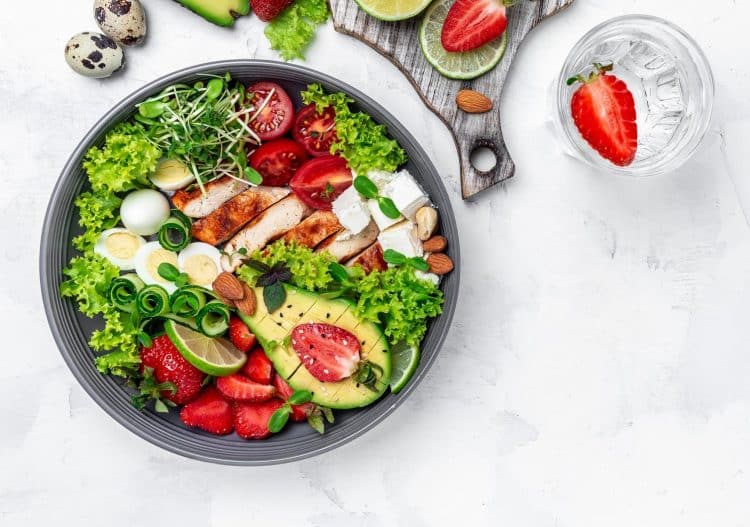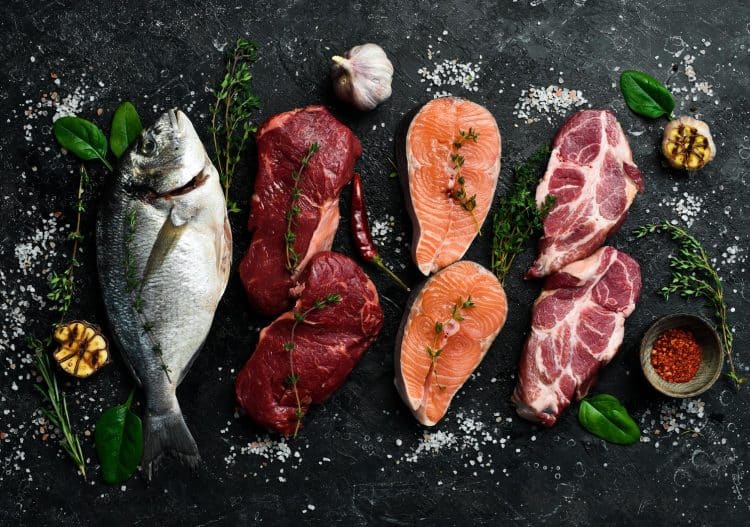Achieving a lean and muscular physique is a common goal for fitness enthusiasts. However, balancing muscle gain and losing fat at the same is a challenging task. To address this, dieticians have created Anabolic Fasting (AF), which combines Dr. Mauro DiPasquale’s anabolic diet with intermittent fasting. This article will explore the key aspects of AF, including its workings, implementation, recommended foods, and pros & cons.
What is Anabolic Fasting?
Anabolic fasting is a diet that combines the anabolic diet developed by Dr. Mauro DiPasquale with an intermittent fasting diet.
The Anabolic Diet
Dr. DiPasquale’s anabolic diet is a carbohydrate cycling diet where you eat a high-fat, high-protein, and low-carbohydrate diet for five days of the week and then load carbs on the two-day weekend [1]. Dr. DiPasquale’s theory is that the anabolic diet gives bodybuilders and powerlifters the ability to gain muscle mass while also losing body fat in place of using anabolic steroids [1,2]. In fact, he claims that the anabolic diet produces the same results as using anabolic steroids [2].
How Does The Anabolic Diet Work?
The anabolic diet is a low-carbohydrate, high-fat diet. High-fat diets are known to activate fat-burning (lipolytic) enzymes and decrease the activity levels of the fat-producing (lipogenic) enzymes, which leads to body fat loss [1, 4]. Through the process of carb cycling, the body switches from using glucose for energy to using free fatty acids for energy, which is referred to as being in a state of ketosis [1, 4].
The anabolic diet also requires that you eat a high protein intake to ensure that muscle mass is not lost [1, 5]. Consuming a high amount of protein not only ensures muscle mass preservation but also provides a greater protein synthesis response, resulting in muscle growth [5].
Level Up Your Fitness: Join our 💪 strong community in Fitness Volt Newsletter. Get daily inspiration, expert-backed workouts, nutrition tips, the latest in strength sports, and the support you need to reach your goals. Subscribe for free!
Intermittent Fasting
Intermittent fasting, also known as time-restricted feeding, is well known for aiding in weight loss [6, 7]. It requires that you set specific hours to eat within. For example, if you follow a 16:8 intermittent fasting routine, you would fast for 16 hours and then eat all of your meals within an 8-hour time frame.
How Does Intermittent Fasting Work?
The results of intermittent fasting are similar to the anabolic diet. After your body completes burning the glucose consumed in the last meal, your body enters into a fasted state, meaning that your body begins to burn fat for fuel instead of glucose [6, 7].
Intermittent fasting can also help you maintain muscle mass while you lose body fat, as long as you consume enough protein [8]. It has also been found to improve insulin sensitivity [9].
Anabolic Fasting
Anabolic fasting is the combination of following an anabolic diet and an intermittent fasting schedule. Given that both the anabolic diet and intermittent fasting produce similar physiological results, combining both may give your body an extra boost in achieving your goals.
How To Do An Anabolic Fast
You may want to condition your body to a low-carb diet for about two weeks before carb cycling to allow your body to adjust. Some people recommend this to make it easier to begin the anabolic diet. However, Dr. DiPasquale does not mention that it is necessary.
To do an anabolic fast, you follow a 5:2 ratio diet. You consume a low carbohydrate, high fat, and high protein diet for five days, followed by a high carbohydrate diet for two days. Most people choose to complete the five low-carb days during the week and save the high-carb days for the weekend so that they have the flexibility to enjoy food in social settings with fewer limitations.
During the 5-day phase, you should limit the number of carbohydrates you consume to 30 grams maximum per day [1]. You can consume these carbs at any point during your day (within the eating window you have established) [1]. Your fat intake should account for about 55-60% of your daily calories, and your protein intake should fall between 30-35% of your daily caloric needs [1].
During the 2-day phase of carb loading, your macros should fall between 45-60% carbohydrates, 30-40% fat, and 10-15% protein [1].
In addition to following the 5:2 anabolic diet, you need to pick an intermittent fasting schedule. Most people who follow an anabolic fasting diet follow a 16:8 intermittent fasting pattern. Following a 16:8 fasting pattern means that you fast for 16 hours of the day and eat all of your meals in an 8-hour window.
Sample Anabolic Fasting Schedule
- Day 0: Begin fasting the night before you begin the diet at 8 PM.
- Days 1 to 5: Eat your first meal of the day at noon. Daily macros should be 55-60% fat and 30-35% protein, with carbs limited to 30 grams a day. Finish your last meal by 8 PM to begin fasting again.
- Days 6 and 7: Break your fast at noon. Daily macros should be 45-60% carbohydrates, 30-40% fat, and 10-15% protein. Begin fasting again at 8 PM.
Repeat this schedule for as many weeks as you want to follow an anabolic fasting diet.
What Can I Eat While Anabolic Fasting?
There are very few limitations to what you can eat during an anabolic fast.
Level Up Your Fitness: Join our 💪 strong community in Fitness Volt Newsletter. Get daily inspiration, expert-backed workouts, nutrition tips, the latest in strength sports, and the support you need to reach your goals. Subscribe for free!
During the 5-day phase of the diet, there are many options for high-fat, high-protein, and low-carbohydrate foods. Any meat can be eaten, [1] such as:
- Steak
- Pork
- Fish
- Benison
- Lamb
- Seafood
- Poultry
Cheese is also a good source of protein and fat [1]. Just make sure to pick full-fat cheeses, not skimmed-milk cheeses, and avoid ricotta and cottage cheeses, as they can be high in carbohydrates (check the nutrition labels) [1]. Eggs are also an excellent food choice for low-carb days. If you find yourself craving sugar during the week, it is allowable to drink low-carb, artificially sweetened beverages [1].
During the 2-day carb-loading phase, you can eat whatever you want without limitations [1]. Dr. DiPasquale states that not even beer and pizza are off limits [1]. However, in the interest of maintaining good health, you should still prioritize eating nutrient-dense meals.
Pros of Anabolic Fasting
The main benefit that draws people to anabolic fasting is that it gives the ability to decrease body fat while increasing lean body mass [1]. Both the anabolic diet and intermittent fasting increase fat-burning (lipolytic) enzymes and lower fat-producing (lipogenic) enzymes, meaning that you burn fat for fuel [1, 4, 6, 7].
The second most popular benefit is that anabolic fasting can increase muscle mass and strength while simultaneously losing body fat [1, 5, 8]. This is possible as long as you consume enough protein [8]. Consuming a high-protein diet can also result in muscle growth and increased strength [1, 5].
In addition, high-fat diets and intermittent fasting diets are both known to increase testosterone and improve insulin sensitivity [1, 2, 3, 9].
Anabolic fasting overall is a very easy diet to follow. There are very few food restrictions for the anabolic diet, and intermittent fasting at a 16:8 schedule is very manageable. You may also find that the anabolic diet curbs your hunger due to the high consumption of fats [1]. Intermittent fasting on a 16:8 schedule is also known to keep you feeling full and reduce your cravings [7, 9].
Cons of Anabolic Fasting
Anabolic fasting comes with little risk to the general population [1,4]. However, there are a few potential unfavorable factors to note.
First, it is common to experience hunger pains while your body is adjusting to a low-carbohydrate time-restricted diet. You may also experience a lack of energy while your body adjusts from using glucose as fuel to fat as fuel.
Carb restriction can also leave you lacking necessary micronutrients and lead to micronutrient deficiencies if the diet is followed for a long duration of time [2]. During the 5-day phase, eating vegetables, fruits, and legumes is very limited [1, 2]. This can result in not only a lack of micronutrients but a lack of antioxidants and fiber [2]. The lack of dietary fiber consumed during the week may lead to constipation [2]. However, it is important to note that Dr. DiPasquale highly recommends taking a fiber supplement when you begin the diet to avoid constipation.
There are also a few negative side effects of consuming a high-fat diet. These negative effects are often referred to as the keto flu, and the most common symptoms include constipation, diarrhea, and vomiting [4]. It is possible to experience these symptoms when you switch from a high-carb diet to a high-fat diet [4]. These symptoms may be avoidable if you follow a low-carb diet for a few weeks before introducing a high-fat diet [4].
FAQs
What is anabolic fasting?
Anabolic fasting is a diet that combines both the anabolic diet and an intermittent fasting diet. The main benefit that draws powerlifters and bodybuilders to anabolic fasting is the ability to lose body fat while also increasing muscle mass.
Is anabolic fasting healthy?
Anabolic fasting is considered a low-risk diet. In general, it is healthy to follow for a short time. However, the lack of complex carbohydrates, fruits, vegetables, and legumes that you are allowed to consume can cause nutrient deficiencies.
How do you eat an anabolic diet?
To eat an anabolic diet, you eat a low-carb, high-protein, and high-fat diet for five days of the week. Then, you eat a high-carb diet for the remaining two days of the week.
Is the anabolic diet the same as the keto diet?
The anabolic diet is very similar to the keto diet as it is a high-fat diet. High-fat diets that limit carbohydrate intake to under 30 grams per day place your body into a state of ketosis.
Wrapping Up
Bodybuilders and powerlifters found that following an anabolic diet gave them great results. Intermittent fasting is also proven to be a safe and effective diet for weight loss. However, due to the lack of nutrients, it is important to note that it would not be healthy to follow an anabolic fasting diet for a long duration of time. Before beginning any new diet, you should see your primary care physician and make sure that the diet will not negatively interact with any pre-existing conditions you may have.
Learn more about fasting
- I’m a Fasting Expert: This is the One Mistake That Destroys Fat Loss During IF
- Inflammation Calculator & Personalized Action Plan
- Dry Fasting Calculator: Estimate Your Weight Loss & Safety Risks
- Intermittent Fasting Weight Loss Calculator: Discover How Much You Can Lose
- Intermittent Fasting vs. Small Meals: Which is Best for Weight Loss?
- 8 Intermittent Fasting Mistakes Beginners Make (And How to Avoid Them)
- I Stuck to an 8-Hour Eating Window for 3 Weeks — Here’s What Happened
- Fat Fasting for Rapid Weight Loss: A Guide to Boosting Ketones and Transforming Your Body
References
- DiPasquale, M. (1995). The Anabolic Diet. Optimum Training Systems.
- Caspero, A., MA. (2019, May 31). Anabolic Diet Basics: Build Muscle and Lose Fat. Healthline.
- Silva, J. (2014). The effects of very high fat, very low carbohydrate diets on safety, blood lipid profile, and anabolic hormone status. Journal of the International Society of Sports Nutrition, 11(sup1). https://doi.org/10.1186/1550-2783-11-s1-p39
- Mawer, R. M. (2020, October 22). The Ketogenic Diet: A Detailed Beginner’s Guide to Keto. Healthline.
- Carbone, J. W., & Pasiakos, S. M. (2019). Dietary Protein and Muscle Mass: Translating Science to Application and Health Benefit. Nutrients, 11(5), 1136. https://doi.org/10.3390/nu11051136
- Collier, R. (2013). Intermittent fasting: the science of going without. Canadian Medical Association Journal, 185(9), E363–E364. https://doi.org/10.1503/cmaj.109-4451
- Seimon, R. V., Roekenes, J. A., Zibellini, J., Zhu, B., Gibson, A. A., Hills, A. P., Wood, R. E., King, N. A., Byrne, N. M., & Sainsbury, A. (2015). Do intermittent diets provide physiological benefits over continuous diets for weight loss? A systematic review of clinical trials. Molecular and Cellular Endocrinology, 418, 153–172. https://doi.org/10.1016/j.mce.2015.09.014
- Tinsley, G. M., Forsse, J. S., Butler, N. K., Paoli, A., Bane, A. A., La Bounty, P. M., Morgan, G. B., & Grandjean, P. W. (2016). Time-restricted feeding in young men performing resistance training: A randomized controlled trial. European Journal of Sport Science, 17(2), 200–207. https://doi.org/10.1080/17461391.2016.1223173
- Sutton, E. F., Beyl, R., Early, K. S., Cefalu, W. T., Ravussin, E., & Peterson, C. M. (2018). Early Time-Restricted Feeding Improves Insulin Sensitivity, Blood Pressure, and Oxidative Stress Even without Weight Loss in Men with Prediabetes. Cell Metabolism, 27(6), 1212–1221.e3. https://doi.org/10.1016/j.cmet.2018.04.010












